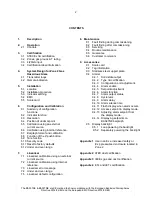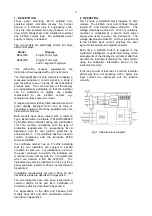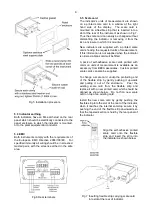
4
2.1 Controls
The indicators are controlled and calibrated via the
four front panel push button switches. In the
display mode i.e. when the indicator is displaying a
process variable, these push buttons have the
following functions:
P
While this button is pushed the
indicator will display the input current in
mA, or as a percentage of the
instrument span depending upon how
the indicator has been configured.
When the button is released the normal
display in engineering units will return.
The function of this push button is
modified when optional alarms are
fitted to the indicator.
▼
While this button is pushed the
indicator will display the numerical
value and analogue bargraph* the
indicator has been calibrated to display
with a 4mA
Φ
input. When released the
normal display in engineering units will
return.
▲
While this button is pushed the
indicator will display the numerical
value and analogue bargraph* the
indicator has been calibrated to display
with a 20mA
Φ
input. When released the
normal display in engineering units will
return.
E
No function in the display mode unless
the tare function is being used.
P +
▼
Indicator displays firmware number
followed by version.
P +
▲
Provides direct access to the alarm
setpoints when optional alarms are
fitted to the indicator and the ‘ACSP’
access setpoints in display mode
function has been enabled.
P + E
Provides access to the configuration
menu via optional security code.
Notes:
*
BA327NE
only
Φ
If the indicator has been calibrated
using the CAL function, calibration
points may not be 4 and 20mA.
3. CERTIFICATION
Both models have ATEX and IECEx gas and dust
certification. The main sections of this instruction
manual describes ATEX gas certification. ATEX
dust approval is described in Appendix 2 and
IECEx gas and dust certification in Appendix 3.
3.1 ATEX Ex nA certification
Notified Body Intertek Testing and Certification Ltd
have issued both instruments with a common Type
Examination
Certificate
number
ITS14ATEX48028X. This has been used to
confirm compliance with the European ATEX
Directive for Group II, Category 3GD equipment.
The instruments carry the Community Mark and,
subject to local codes of practice, may be installed
in any of the European Economic Area (EEA)
member countries and in the EEA EFTA states,
Iceland, Liechtenstein and Norway. ATEX
certificates are also acceptable in Switzerland and
Turkey. The European Commission's Blue Guide
lists the member states, overseas countries and
territories that have adopted harmonisation
legislation.
This section of the instruction manual describes
ATEX installations in explosive gas atmospheres
conforming with BS EN 60079-14:2008
Electrical
installations design, selection and erection
. When
designing systems for installation outside the UK
the local Code of Practice should be consulted.
3.2 Zones, gas groups and T rating
The indicators have been certified as Group II
Category 3G Ex nA ic IIC T5 Gc apparatus and
may be used in an ambient temperature Ta
between – 40°C to +70°C. This is non-sparking
apparatus complying with BS EN 60079-15
Equipment protection by type of protection 'n'
that
minimises the risk of arcs or sparks capable of
creating an ignition hazard occurring during
conditions of normal operation.
Special conditions for safe use are specified by the
Ex nA certificate indicated by the certificate
number's 'X' suffix. These state that the indicators
should be correctly mounted in a panel enclosure
complying with the requirements specified in
BS EN 60079-15:2010 for Equipment protection by
type of Protection 'n'. For Category 3 installations
in Zone 2 self or third party certified Ex n, Ex e or
Ex p panel enclosures may be used. Additional
requirement apply for non-metallic panel
enclosures.
BS EN 60079-17
Electrical installations inspection
and maintenance
permits live maintenance in Zone
2 if a risk analysis demonstrates that this does not
introduce an unacceptable risk. The removal of
covers [opening of Ex n enclosure] is permitted if





































